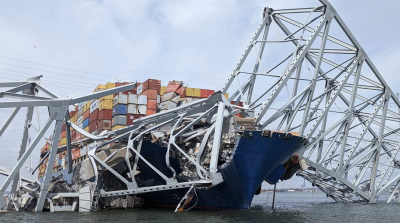Recently, a casualty occurred on a passenger vessel operating about a mile offshore in the Atlantic Ocean. A crewmember, while making a round in a machinery space, noticed that a small fuel spray fire had developed above one of the four propulsion engines. The crewmember vacated the space and informed the bridge watch. Subsequently, proper emergency procedures were followed, ventilation to the machinery space was secured, and the CO2 via the fixed fire fighting system was released. Fortunately for the 174 persons onboard, the fire was quickly extinguished without incident or additional complications. Although the investigation is not complete, important causal factors were discovered and are shared here.
The vessel was equipped with four Detroit Diesel sixteen cylinder high speed engines - model 16V92. The engines were constructed by coupling two V-8 cylinder engines together. There are also other similarly coupled engine models and in widespread use including the Detroit Diesel 12V92, 12V71, and 16V71. Fuel and coolant flow from head-to-head and within passages on each side of the engine. The fuel supply passage delivers fuel to the injection equipment of each cylinder. A return passage handles excess fuel. To connect the heads on each side of the engine, a male-to-male threaded variable length coupling is used by design. There are four couplings per engine that handle fuel supply and returns from the injection components. These couplings are unique in that they facilitate installation by their capability to lengthen when their ends are threaded into the heads.
On the passenger vessel that experienced the engine room fire, couplings on three of the four engines were replaced with threaded hose barb fittings and rubber hose. One of those fuel hoses subsequently failed and sprayed fuel directly onto the main engine exhaust lagging and blankets. The seam in the insulation blanket was facing towards the engine rather than away and likely provided the ignition source.
As a result of this casualty the Coast Guard strongly encourages owners, operators, and marine engine rebuilders with the types of engines listed above, either as propulsion or prime movers for generators to:
- Always use proper replacement parts,
- Consider seam placement of exhaust insulation blankets and lagging during installation,
- Follow good marine practice by always maintaining the tightness and correct fit of the insulation blankets over the entire exhaust system, and
- For those who repair or own and operate vessels with these Detroit Diesel engines either as propulsion or electrical generation equipment of design configuration 16V92 ,12V92, 12V71 and 16V71, inspect and verify that the proper head to head couplings are used for the fuel supply and return passages. If incorrect, contact an authorized manufacturer technician for specific guidance.
Also, during a recent Coast Guard inspection of an amphibious passenger vessel / DUKW (“duck”) boat, a marine inspector discovered water back-flowing into the vessel’s bilge while testing the vessel’s bilge pump system. An expanded inspection of the system revealed a severely wasted and holed section of the steel bilge piping leading vertically to the overboard bilge discharge port. After inspecting the remaining fleet of six vessels, the same problem was discovered, in various degrees of severity, on four other vessels.
The failure of this piping creates an extremely unsafe condition by rendering the vessel’s bilge pumping system ineffective. Because the wasted section of piping is hidden behind inner sidewalls within the passenger seating section, the problem can persist and evade detection by the vessel owner or operator.
The U.S. Coast Guard strongly encourages owners, operators, and other persons involved with the inspection of these types of vessels to:
- Immediately trace out and inspect the entire bilge piping system for wastage or deterioration of metal bilge piping, check the condition of all hoses, hose clamps, supports and make repairs as needed.
- Make the inspections of these concealed components part of the vessel’s overall routine inspection process.
- Consider installing an access plate on the inner panel at the area of the discharge piping so that the piping is easily accessible for inspection and maintenance. (See image at right)
- Inform the appropriate Coast Guard personnel if the system piping has changed significantly or in any way that may require regulatory notification, oversight or guidance for permanent repair solutions.




